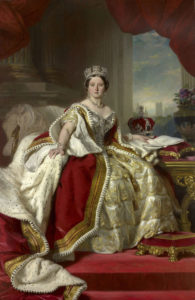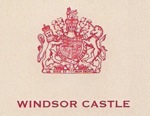 Queen Victoria (Alexandrina Victoria) (24 May 1819 – 22 January 1901) was the Queen of the United Kingdom of Great Britain and Ireland from 20 June 1837, and the first Empress of India of the British Raj.
Queen Victoria (Alexandrina Victoria) (24 May 1819 – 22 January 1901) was the Queen of the United Kingdom of Great Britain and Ireland from 20 June 1837, and the first Empress of India of the British Raj.
Victoria was related to most of the crowned heads of Europe and many aristocrats, including Tsar Alexander I (her godfather), Alfred Duke of Edinburgh, Augusta Duchess of Cambridge, Edward VII, Ernest Augustus I, George V, George VI, Leopold I Belgium,
Victoria married Prince Albert, who came from a family tradition of homeopathy, and when he came to England to marry Queen Victoria, he renewed the Royal patronage of homeopathy.
Queen Victoria was an advocate of homeopathy, and a patient of James Manby Gully. Her own household physician, John Forbes, was a student of homeopath Friedrich Wilhelm Karl Fleischman, and a friend of William Henderson, Florence Nightingale, John Ozanne, Robert Peel, and homeopathic doctor David Wilson. Although Forbes was not an homeopath, he did remain unbiased and even handed and so remains a shining light in medical journalism. Forbes, no doubt mindful of his royal patient’s support for homeopathy, was even recorded as saying
“… It is utterly impossible to disregard the claims of homeopathy as an established form of practical medicine, as a great fact in the history of our art; we cannot ignore it… for not only do we see all our ordinary diseases cured homeopathically, but even all the severer and more dangerous diseases which demand by the common method prompt and strong measures to prevent a fatal issue…”
Victoria also employed Andrew Combe as her physician extraordinary in Scotland, along with Joseph Bell, and Thomas Spencer Wells who, like Charles Darwin, was a patient of homeopath James Manby Gully. Victoria was also a patient of James Clark, Charles Locock 1st Baronet, James Young Simpson, and Henry Holland 1st Baronet who, in 1854, issued the 3rd Edition of his Medical Notes and Reflections, and his Chapters on Mental Physiology, which contained several allusions to homeopathy. At various points in the book Holland noted how orthodox medicine could be unscientific with no principle to guide it, discussed matching symptoms to the remedy, and observing primary and secondary effects of the remedy.
A surviving letter written by influential homeopathic physician Frederick Hervey Foster Quin indicates that he dined with Queen Victoria, possibly in the 1870s. Not only does this reveal the connections Quin maintained within the uppermost levels of British society, it also suggests Victoria recognized Quin as a noteworthy figure within British homeopathy:
“I shall be charmed to have the honor of dining at St James Palace tomorrow Saturday and present my dutiful respects to Her Royal Highness, and have the honor of meeting the Duke ‘en partie guarée’. Many many thanks for your kind & thoughtful hints about there being no stairs to mount. This horrid cold weather has crippled me in the ‘bud’, don’t laugh, I allude to the ‘bud’ of my second childhood which is hastening on, only my brain instead hardening with the ice as I fear softening. I am nevertheless yours very faithfully.”
In 1887, Thomas Graham Balfour, another colleague of Florence Nightingale, who was noted for his research into the use of belladonna in preventing scarlet fever, was appointed honorary physician to Queen Victoria.
Queen Victoria‘s favourite Prime Minister Benjamin Disraeli, 1st Earl of Beaconsfield, was a patient of homeopath Joseph Kidd on the recommendation of Queen Victoria herself .
Another of Victoria’s Prime Ministers, Henry Palmerston, was a supporter of homeopathy, and his wife was also a homeopathic patient. Victoria’s Lady of the Bedchamber, Charlotte, Countess Canning was a patient of Paul Francois Curie, and her aide de camp was homeopathic supporter and patron of the London Homeopathic Hospital, William Coutts Keppel Viscount Bury 7th Earl of Albemarle. Victoria also knew Christian Karl Josias Bunsen, Alfred Edward Chalon, Edwin Henry Landseer, Philippe Musard, Alfred Lord Tennyson, Arthur Wellesley 1st Duke of Wellington.
Victoria and Prince Albert were also advocates of phrenology.
Though Victoria ascended the throne at a time when the United Kingdom was already an established constitutional monarchy in which the king or queen held few political powers and exercised influence by the prime minister’s advice, she still served as a very important symbolic figure of her time.
Victoria’s reign was marked by a great expansion of the British Empire; during this period it reached its zenith, becoming the foremost global power of the time. Of mostly German descent, Victoria was the daughter of Prince Edward Augustus, Duke of Kent and Princess Victoria of Saxe Coburg-Saalfeld, and granddaughter of George III and the niece of her predecessor William IV.
She arranged marriages for her nine children and forty two grandchildren across the continent, tying Europe together and earning her the nickname “the grandmother of Europe”.She was the last British monarch of the House of Hanover; her son Edward VII belonged to the House of Saxe Coburg and Gotha.



Leave A Comment